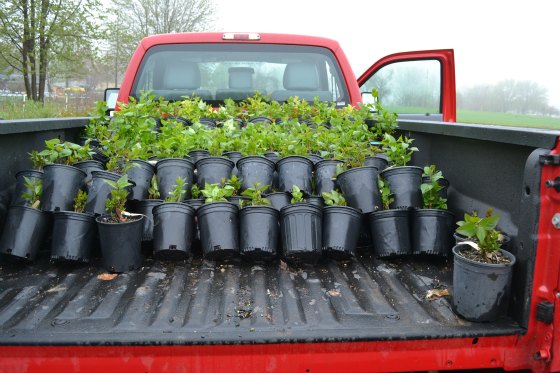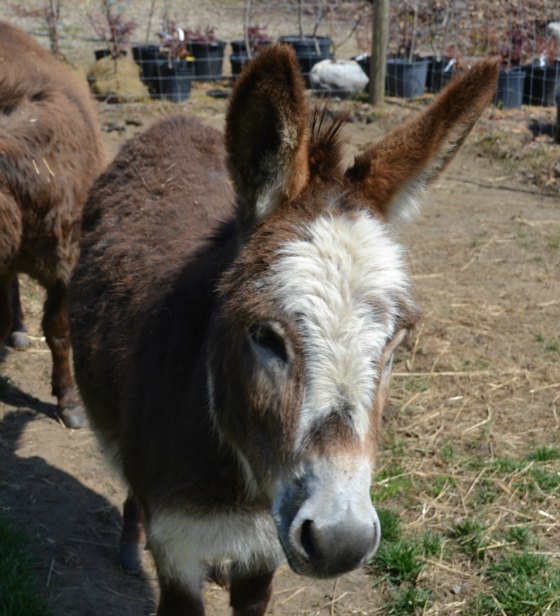What??? Why would anybody want to do that or need to know that?
Legitimate question for sure.

One gallon plants stacked in a truck.
The reason that I decided that this was a post worthy of putting on my blog is because when I mentioned In Our Members Area that I purchased 400 one gallon Lilacs for my sale last spring at least one members suggested that he’d like to see you can possibly fit 400 one gallon plants in a standard pickup truck bed.
Secondly I am always reminding the members to think bigger.
Think about the guy that I bought these 400 plants from. In about 45 seconds he sold 400 plants to one customer. That’s how the wholesale side of this business works. Wholesale buyers don’t walk around the sales area taking great lengths of time to pick out the plants they want to buy. When I bought these 400 plants (I actually bought 500 because the first batch sold so well I went back and got another 100 plants.) the conversation went like this . . .
***********************************************************************************************************
John, do you still have some one gallon lilacs?
Yes I do.
How much?
$5.00 each?
I’ll take 400, you can just mix up the varieties but can you hold them until May 1st so I don’t have to worry about them freezing.
Sure.
***********************************************************************************************************
And as simple as that John sold 400 one gallon lilacs @$5.00 each.

Stacking containerized plants in a truck is a skill, almost an art.
That’s why a grower has to know how to stack plants in a truck. Once you realize that wholesale buyers often buy hundreds or thousands of plants at a time, you have to know how to get as much product on a truck as possible, without damaging the plants.
This looks like it would do damage to the plants but that’s not the case. Plants stacked like this, often has high as seven pots per tier are shipped across the country. As a very young man working in a nursery I worked on the loading dock and we would load trucks of all sizes, stacked full of plants. Sometimes a landscaper’s pick up truck as in this photo, but often times semi trailers where the plants had to travel long distances. And of course you can’t send a truck a long distance unless it is packed full. Freight charges are high, you have to reduce the cost per plant for shipping as much as possible.

How to stack plants in a truck.
Stacking plants like this is pretty simple. Of course you start all the way forward in the truck. What I usually do is start with the first row sitting flat on the bed of the truck. The second row of plants is leaned against the first at what I would say is an angle of 25 degrees. Each row of plants is placed in the middle of two plants that they are leaning against. This allows for the top of the plant to fall into a void between two pots so the tops of the plants are not damaged.
Getting the first row of leaning pots started is a bit of a challenge. What I usually do is use the tip of my work boots to keep the plants in place as I place the second row on top of the first. Once the second row is added the plants tend to stay in place if you have the correct amount of angle.
As each additional row of pots is added you can also add a additional tier. The first row is only one plant high, the second row two plants high, the third row three plants high and so on. Typically you don’t want to go more than seven tiers high.
When I worked in that wholesale nursery they used to buy semi trailer loads of one gallon plants from a nursery in California, shipped to northern Ohio. They’d stack them 7 high from the front of the trailer to the back door of the trailer. When you’d open the door of the truck all you could see was a wall of pots and plants, seven feet high, forty five feet deep. As I recall that amounted to 7,000 one gallon plants in one semi truck!
Why would a wholesale nursery who grows their own
plants buy 7,000 plants from another grower?
And that’s the part of this industry that most people just don’t understand. The demand for plants, especially when the economy is good as it is now, often far exceeds a nurseries ability to meet that demand. It often takes several years to produce a landscape quality three gallon container. Many growers who find themselves sold out of plants that are in great demand will buy nice full one gallon plants from another grower, shift those one gallon plants into three gallon containers, let them flush out and root in for one growing season, or often just part of one growing season.
Not only do they they make a nice profit on those plants, but they keep their customers from looking elsewhere for the plants that they need. In the mean time it gives them time to up production of their own stock.

Finnegan the miniature donkey.
Finnegan and Fergus can tell you all about the wholesale market for plants. Their pen is right next to one of the biggest wholesale nurseries in Ohio. They watch the workers plant, trim and dig tens of thousands of plants at a time every single day. The Donkeys will tell you that the market for plants is huge.
Our Latest Donkey Photos are here.
This is a crazy, crazy fun business where opportunities to sell more plants abound. This is something that I am always trying to impress Upon Our Members. The true money is made on the wholesale side of this business. You always have to think bigger. You have to pay attention to the market and know what is likely to be in huge demand.
The demand for nice plants is so great that often times plants offered for sale in our members area completely sell out before most can even see the ad. It’s crazy how fast some of our members sell out of plants.
Can 80 3 gallon muhly grass fit stacked in a F150 short bed 5ft bed
Jeannette,
I would say so, no problem with stacking.
What are you using to protect them from wind
Damien,
Either a plastic tarp or a burlap tarp.
Can you fit 500 in an suv that seats lay flat so they’re protected from wind?
Damien,
Maybe not 500, but a couple hundred and that’s a great way to transport plants. Best vehicle I ever had for moving plants was a panel van.
Do the plants need to be covered to protect from wind damage while travelling?
Yes, they do unless completely dormant.
Hello Mike!
I just happen to run across your backyard growing and how you share your info and knowledge to help others be successful in trying to grow a green thumb for themselves. “Thank You Sir” for sharing. Here is what I’m referring to!
I have an old pear tree that produces one of the best tasting fruits that I have ever eaten. It’s never pruned or anything ever done to it. It stands I’m guessing 40 feet tall and 2 feet across the base. Not a grit type meat but more shape and look of a half apple half pair fruit. I would like to take clippings from this tree and try to “clone” so to speak, this tree. I don’t want to change it, just get new trees growing that will be younger than my old tree, yet produce the same fruit.
Will I have to graft this to another root stock or is it possible to root a clipping from this tree and grow it strong?
Do you have any suggestions that you have done yourself and know it will still have the same results as the 50 year old pear tree? I think the root stock of this pear tree now grows 30 feet away and is I’m guessing 8-10 years old now. It produces a small sort of crab apple.
Thanks for your help and again, Thank You for offering your knowledge to help others!
Marcuz
Marcuz,
I’m not sure that cuttings would work but if it were me, I’d try air layering it. Search that on youtube, or see this http://airpropagator.com That will take many months, but it will give you an exact clone of your tree and you end up with a nice size off spring to start with.
So it sounds like it would be smart to grow around 2000 of one plant and then sell each one for 5 dollars to different wholesalers then you can make a lot of money fast something like spirea or weigela so they are nice sellers and you can get many cuttings.im that 13 year old.
Hunter,
Yes and no. 2,000 of a plant that is high demand, slower growing plants typically fall into this category. Fast growing plants are usually plentiful on the wholesale market. Starting out a well rounded variety is a good place to start. Email Duston in the office, he has something for you. [email protected]
Mike, how about using a 2 x 4 under that second row that needs to have a 25 degree lean? That’s what I do…I just cut it to fit across the back of the truck. Maybe a 2 x 2 would work too. I just used what was available. Works for me! Have a wonderful day!
Anne,
You can, but I’ve always kept them in place with my toes as I stack on top of them. Just put 400 one gallon lilacs in the bed of my pickup last week.
Just delivered 500 potted blueberry plants; half the truck was loaded the way you show. The other half was laid down with the pot toward the cab and the plant toward the tail gate. Staggering the pots so the tops fall in that empty space work great both ways; the second way, you reverse the pot toward the tail gate filling in the spaces as you work toward the part already laid out. Took 120 standing; 380 lying down. Happy plants, happy customers! The huge trucks load the way Mike showed above–many, many plants are shipped this way…
My customer is/was a long-time-ago acquaintance who found me through Mike’s BYG Buy/Sell Board. Thanks, Mike, for the opportunity to grow plants and grow a bigger business…
Patrica,
First of all congratulations to you for being such a great student and congrats on selling 500 blueberry plants to one customer. I know I don’t have to ask you about the value of membership, I know you sell a lot of blueberries to other members. http://backyardgrowers.com/join
Most importantly when loading plants is to think about what happens when the brakes get slammed on. It’s imperative that plants don’t go flying forward or sliding forward breaking them into pieces.